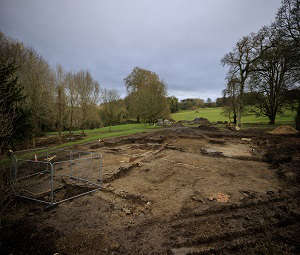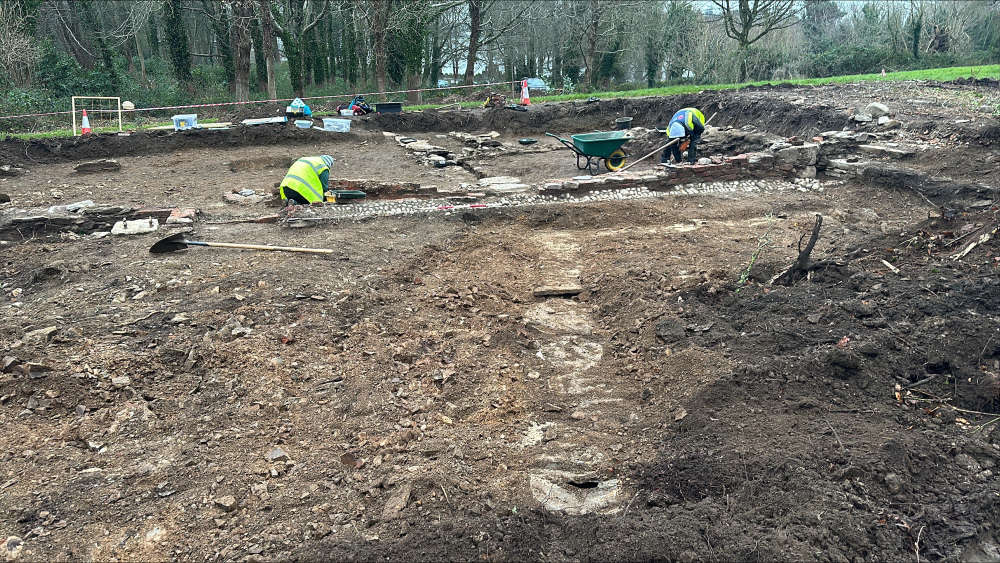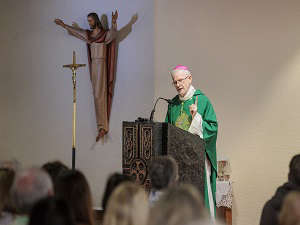
By David Young (PA)
Undocumented remains of a 300-year-old complex of buildings have been discovered by chance during routine drainage work on a country house estate.
The foundations of a courtyard and surrounding buildings were unearthed in an area of thick vegetation on the grounds of Castle Ward in Co Down during the installation of a drain filtration system.
The discovery at the National Trust property has taken archaeologists completely by surprise, as there is no record of the structures on any of the estate’s historical maps or documents.
It was found as a trench was being dug to bring a pipe from the existing buildings at Castle Ward down to a reed bed.
Archaeologists were on site monitoring the work at the time just in case anything of significance was found.
But they never expected what was revealed after the first few red bricks were uncovered.
As the topsoil was stripped back further, the remnants of a collection of buildings was exposed for the first time in three centuries.
Around a central, cobbled courtyard, there were a series of buildings, some with tiled and flagged floors. A sink, fireplace, cellar and network of stone-lined drains have all been identified.
Several artefacts have also been found, including pottery, glass bottles, ceramics and discarded, butchered, animal bones.
Construction on the existing country mansion at Castle Ward began in the 1760s but there was an original house predating that, which was built in the early part of the 18th Century.
Experts believe the newly discovered remains date back to the late 1600s or early 1700s and may have been a domestic and farm-related complex of buildings utilised by the first Castle Ward house.
One theory is the complex was destroyed when the new mansion was built because it would have been an eyesore in the way of the property’s stunning view of Strangford Lough.
Malachy Conway, the National Trust’s regional archaeologist for Northern Ireland, said the discovery was “really significant”.
He said the find was completely by chance because the route and location of the drainage system had been carefully chosen in line with old historical maps to avoid any site of potential archaeological significance.
“There was nothing on our maps that was showing anything to be there and then, lo and behold, they stumble upon and suddenly find previously unknown building remains,” said Mr Conway.
“By and large, these are non-residential buildings, it’s almost a sort of mini-stable yard, or it’s a place where you’ve got possibly a little dairy or maybe where the laundry was.
“We think this was the precursor to what was then built at the new house, the stable yards you see today.”
Michael Fearon, from Northern Archaeological Consultancy, was on site monitoring the drainage system construction when the discovery was made.
The junior site director has overseen the subsequent excavations.
“The reed beds are located in an area of dense vegetation and trees, and it was during clearance works that bricks were discovered,” he said.
“What looked like just a few bricks at the start just kept expanding and expanding once we went in with the machine to investigate what it was.
“It was a big surprise”.
Mr Fearon added: ”We’re thinking that, maybe, our collection of buildings existed before the Castle Ward main house of today was constructed and it might have been an eyesore from the window, so they decided to demolish that just so that it was not in view out their windows.
“They wouldn’t have wanted anything that would detract from the natural landscape.”
Adrian McAleenan, senior archaeologist in the Historic Environment Division (HED) of Stormont’s Department for Communities, said the excavations had uncovered some exciting finds.
“HED has a key role in new archaeological discoveries such as this, from advising on the archaeological works required in advance of new development, to licensing excavations in order to manage the process of archaeological discovery and recording,” he said.
“The excavations at Castle Ward have resulted in exciting and important new information about our past, from the discovery of a well-preserved complex of buildings to the uncovering of a tiny and fully intact ceramic pot, all of which sat just beneath the ground surface and are likely to be at least 300 years old.”

Excavation at the remains of a dwelling dating back to the 18th century that has been discovered at Castle Ward in County Down


 New IRA had planned earlier attack on detective John Caldwell, court told
New IRA had planned earlier attack on detective John Caldwell, court told
 Man in court over murder of Stephen Brannigan and attack on priest in church
Man in court over murder of Stephen Brannigan and attack on priest in church
 Co Down community ‘shaken and upset’ after priest attack and death of man
Co Down community ‘shaken and upset’ after priest attack and death of man
 Murder probe may be linked to ‘brutal attack’ on priest, say police
Murder probe may be linked to ‘brutal attack’ on priest, say police
 Woman and two children injured in road crash
Woman and two children injured in road crash